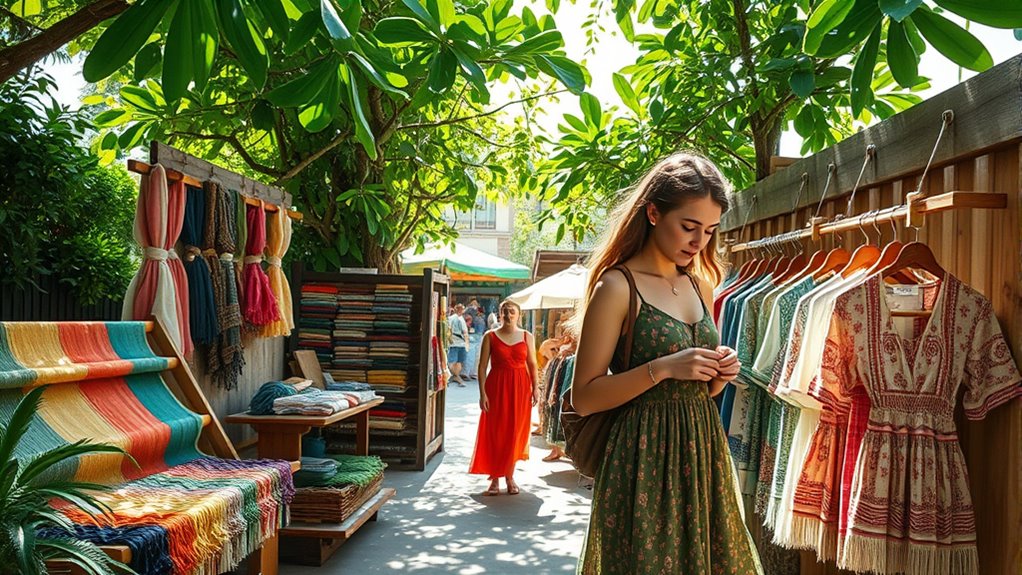Sustainable fashion has grown beyond a fleeting trend because more consumers like you are prioritizing environmental and ethical issues in your choices. This shift happens as brands focus on fair sourcing, eco-friendly dyes, and durable fabrics that reduce waste. Your demand for transparency and responsibility encourages the industry to change. If you want to understand how this movement continues to evolve and influence your wardrobe, keep exploring what makes sustainable fashion more than just a passing fad.
Key Takeaways
- Growing consumer awareness about environmental and social impacts has driven demand for ethically produced, sustainable fashion.
- Brands increasingly adopt transparent supply chains and eco-friendly materials, making sustainability a core business value.
- Influencers and activists have amplified the movement, turning sustainable fashion into a cultural and lifestyle statement.
- Regulations and industry standards now encourage ethical sourcing and environmentally friendly practices.
- The focus on quality, durability, and responsible consumption has shifted sustainable fashion from trend to long-term commitment.

Have you ever wondered how your fashion choices impact the planet? It’s no secret that the way clothing is made can have significant environmental and social consequences. That’s why more people are turning to sustainable fashion, a movement that emphasizes ethical sourcing and eco friendly dyes. When brands prioritize ethical sourcing, they guarantee that the materials come from suppliers who treat workers fairly and follow safe, humane practices. This means no child labor, fair wages, and safe working conditions. By choosing brands committed to ethical sourcing, you support a supply chain that respects human rights and reduces exploitation. It’s about making conscious decisions that align with your values and promote positive change in the industry.
Choosing ethical brands supports fair labor and positive industry change.
Eco friendly dyes play a vital role in this shift. Traditional dyeing processes often use toxic chemicals that pollute waterways and harm ecosystems. But sustainable fashion brands are adopting eco friendly dyes, which are derived from natural, biodegradable sources like plants, minerals, or recycled materials. These dyes not only reduce environmental harm but also produce vibrant colors without the health risks associated with synthetic dyes. When you buy garments dyed with eco friendly dyes, you’re helping to lower water pollution, decrease chemical waste, and support innovative, greener technologies. It’s a simple way to make your wardrobe more sustainable without sacrificing style.
The shift toward sustainable fashion is driven by a growing awareness of how fast fashion contributes to environmental degradation. Fast fashion encourages mass production and rapid consumption, leading to massive waste and pollution. By contrast, sustainable brands focus on quality, durability, and transparency. They often use ethical sourcing practices for fabrics like organic cotton, hemp, or recycled fibers, reducing reliance on resource-intensive crops and minimizing environmental impact. This means you can feel confident that your clothing isn’t just trendy but also responsibly made. Sustainable fashion encourages you to think longer about your purchases, opting for pieces that last and support ethical practices.
As you become more conscious of your environmental footprint, you start to see how your choices influence the industry. Supporting brands that prioritize ethical sourcing and eco friendly dyes creates a ripple effect, encouraging others to adopt similar practices. It’s about shifting from passive consumer to active participant in a movement that values sustainability, fairness, and innovation. The more you learn and choose consciously, the more sustainable fashion becomes a lasting part of your lifestyle rather than just a fleeting trend. Ultimately, your wardrobe becomes a reflection of your commitment to a healthier planet and a more equitable world.
Frequently Asked Questions
How Can Consumers Verify the Sustainability Claims of Fashion Brands?
You can verify a fashion brand’s sustainability claims by checking for supply chain transparency, ensuring they disclose sourcing and manufacturing details. Look for third-party certifications like Fair Trade or GOTS, which validate eco-friendly and ethical practices. Research the brand’s website and reviews to see if they’re open about their efforts. Asking questions directly or consulting trusted sustainability guides also helps you make informed choices.
What Are the Biggest Challenges Brands Face When Adopting Sustainable Practices?
You’ll find that the biggest challenges brands face when adopting sustainable practices are balancing ethical sourcing with cost and maintaining supply chain transparency. While it’s easier to promote eco-friendly materials, ensuring all suppliers meet these standards requires constant oversight. This juxtaposition of sustainability and profitability often complicates efforts, making it tough for brands to fully commit without risking higher prices or operational delays, yet transparency remains essential for genuine sustainability.
How Does Sustainable Fashion Impact the Global Economy?
Sustainable fashion impacts the global economy by promoting ethical sourcing and fair labor practices. You’ll see increased demand for eco-friendly materials and fair wages, which can boost local economies and create jobs. However, it also challenges traditional industries to adapt, often incurring higher costs. Overall, sustainable fashion encourages responsible growth, helping you support brands that prioritize environmental health and worker rights, shaping a more equitable global marketplace.
Are Sustainable Fabrics More Affordable Than Conventional Ones?
Think of sustainable fabrics as the underdog in a race—sometimes they’re more affordable, sometimes not. When you compare costs, material options matter: eco-friendly materials like organic cotton or recycled polyester can be budget-friendly or pricier than conventional fabrics. It largely depends on the supply chain and quality. So, while they aren’t always cheaper, choosing sustainable options often means investing in better, more responsible fashion.
What Role Do Governments Play in Promoting Sustainable Fashion Initiatives?
Governments play a vital role in promoting sustainable fashion initiatives through policy enforcement and funding incentives. You can support these efforts by advocating for stronger regulations that encourage eco-friendly practices and by urging policymakers to allocate funds for sustainable research and development. When governments prioritize sustainability, they create a more level playing field, making it easier for brands and consumers to choose eco-conscious options and drive the industry toward a greener future.
Conclusion
As you embrace sustainable fashion, remember it’s more than just a fleeting trend—it’s a movement with the power to transform the industry. But the real question is, how will your choices influence this shift? Will you stand by and watch change happen, or will you become part of the solution? The future of fashion is unwritten, and your next decision could be the one that sparks a lasting revolution. Are you ready to make it count?










